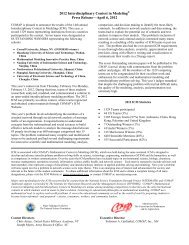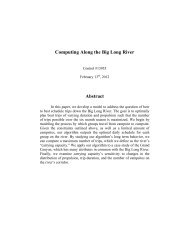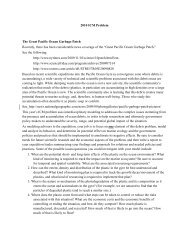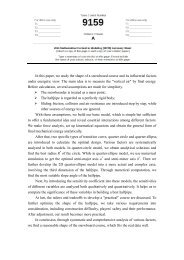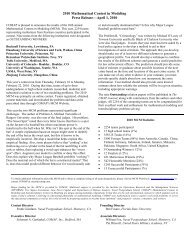Centroids, Clusters and Crime: Anchoring the Geographic Profiles of ...
Centroids, Clusters and Crime: Anchoring the Geographic Profiles of ...
Centroids, Clusters and Crime: Anchoring the Geographic Profiles of ...
Create successful ePaper yourself
Turn your PDF publications into a flip-book with our unique Google optimized e-Paper software.
Team # 7507 Page 21<br />
crimes contained within two square kilometers, any buffer zone would have to be small).<br />
Our second test data-set, coded “Offender B,” (see Figure 6) is similarly successful, with<br />
k s = 12.15. Here, <strong>the</strong> fit parameters <strong>of</strong> <strong>the</strong> Γ estimate <strong>the</strong> existence <strong>of</strong> a substantially larger<br />
buffer zone than for Offender C, but <strong>the</strong> substantial dispersion <strong>of</strong> <strong>the</strong> points along <strong>the</strong> horizontal<br />
axis results in a larger outer radius, so that a similar portion <strong>of</strong> <strong>the</strong> high-likelihood grid points<br />
appear “ wasted,” particularly in <strong>the</strong> upper right section <strong>of</strong> <strong>the</strong> crater.<br />
connections are negligible with δr ¯ = −0.0076 .<br />
Here too, temporal<br />
Just as our naive desire to extrapolate from two data points begins to insist our model must<br />
be robust, we apply our model to Offender A <strong>and</strong> find a clear example <strong>of</strong> how it can fail. In<br />
this case, <strong>the</strong> last crime (see Figure 7) is one <strong>of</strong> two substantial outliers, <strong>and</strong> in fact, with a<br />
st<strong>and</strong>ard effectiveness multiplier <strong>of</strong> k s =0.38, our model is nearly three times less helpful<br />
than <strong>the</strong> average r<strong>and</strong>om guess in selecting a distribution <strong>of</strong> resources <strong>and</strong> manpower. Note,<br />
however, that <strong>the</strong> vast majority <strong>of</strong> previous crimes are still well-described by <strong>the</strong> model, so <strong>the</strong><br />
assumption <strong>of</strong> an anchor point somewhere within <strong>the</strong> crater region does not appear to have been<br />
a poor one. It is simply <strong>the</strong> case, as it will <strong>of</strong>ten be in real life, that some scheme, whim, or<br />
outside influence caused <strong>the</strong> criminal to deviate sharply from his previous pattern in this case.<br />
As remarked in <strong>the</strong> development <strong>of</strong> our metric, testing <strong>the</strong> model on <strong>the</strong>se three data points<br />
alone is hardly sufficient to draw any broad conclusions about <strong>the</strong> utility <strong>of</strong> our model in a general<br />
setting. Still, since <strong>the</strong>se three data sets were selected arbitrarily from published literature<br />
from within samples considered to be highly representative <strong>of</strong> typical serial killings, it is at<br />
least reassuring that our model is somewhat successful in two <strong>of</strong> three cases, <strong>and</strong> it is hard to<br />
imagine any model being highly successful in <strong>the</strong> third case.<br />
7.3 Extensions<br />
Several <strong>of</strong> <strong>the</strong> test cases considered above stray from <strong>the</strong> idealized, radially symmetric distribution<br />
which centroid model assumes. In particular, <strong>the</strong> data from <strong>of</strong>fender B has considerably<br />
more variation along <strong>the</strong> horizontal axis than <strong>the</strong> vertical, <strong>and</strong> informally, it appears an elongated<br />
ellipsoid might be a better fit than a perfect circle. Alternatively, one might imagine that<br />
points on <strong>the</strong> right <strong>and</strong> left <strong>of</strong> <strong>the</strong> circle should have higher likelihood scores than <strong>the</strong> ones in<br />
<strong>the</strong> top <strong>and</strong> bottom, as though some <strong>of</strong> <strong>the</strong> volume under <strong>the</strong> crater surface had ”gravitated” towards<br />
<strong>the</strong> regions more dense with points. Indeed, <strong>the</strong>re is some empirical evidence to suggest<br />
that many serial crime patterns display such angular asymmetries.[13]<br />
The first idea could be accomplished by constructing a special, two dimensional distribution<br />
function which would fit <strong>the</strong> points elliptically, or <strong>the</strong> construction <strong>of</strong> <strong>the</strong> function in a space<br />
where <strong>the</strong> geometry was non-Euclidean <strong>and</strong> determined by <strong>the</strong> presence <strong>of</strong> past-crime data







